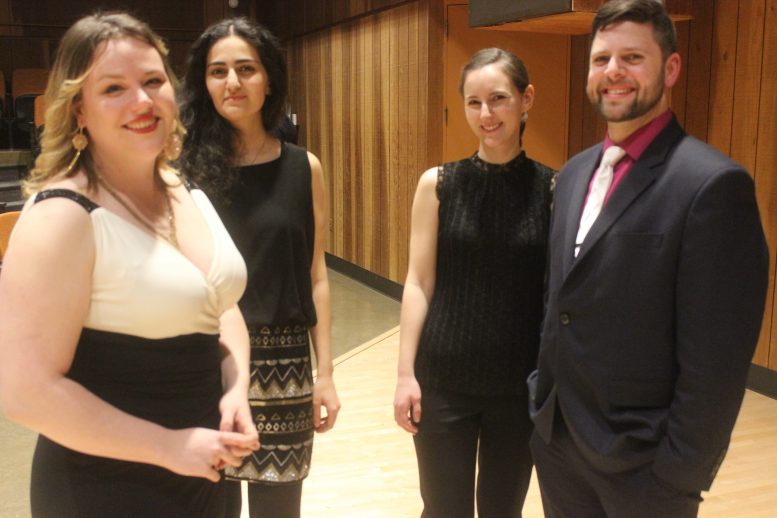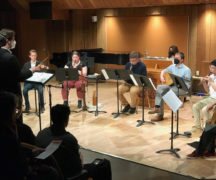By DAVID DUPONT
BG Independent News
Nine singers, each with a trusty pianist by their side, sang their hearts out in a smorgasbord of languages Saturday night.
The nine duos were performing in the finals of the Conrad Art Song Competition in Bryan Recital Hall, of the Moore Musical Arts Center.
True to the rules of the event, each singer had to tackle songs in at least four languages — French, German, Italian, and English. For some even that wasn’t enough.
The graduate division winners, soprano Mickey Miller and pianist Humay Gasimzade, added a song in Swedish. The undergraduate division winning duo of baritone Nick Kottman and Emily Morin performed a Russian song in the semifinals earlier on Saturday.
And Nigerian mezzo soprano Eunice Ayodele brought a taste of her home to the competition by performing a song in Yoruba. She and pianist Jiamo Zhang placed third in the graduate division.
The two winning duos, though, opened their sets in the finals in English, colloquial English at that.
Miller and Gasimzade came out with Cheryl Francis-Hoad’s “Rubbish at Adultery.” In some decidedly PG-13 language, the song’s narrator explains to her overly sensitive lover that he is failing at cheating.
Miller played up the roll. Each of her darts hitting its mark. “It’s such a joy to perform,” she said of the song.
Kottman and Morin opened with “Nude at the Piano,” in which the singer laments having been abandoned by his lover, and left with the piano he cannot play.
In the finals, the competitors choose their first piece, and then the judges selected one or two more for them to sing.
“I was afraid they weren’t going to choose it,” the baritone said explaining why he and Morin opened with the comic number. “I really enjoy the different dynamics in it. I go from being angry to sad.”
He moves around, plopping himself on the edge of the piano bench, interacting with Morin.
“I get to do a little more than park and bark,” he said.
Morin enjoys the piece as well. The music is knotty and difficult, a peek into the character’s tortured psyche.
“I really like the harmonic language, and the way it fits with the text and all the little gestures that … intertwine with the vocal phrases,” Morin said.
At one point the music “kind of wanders up the keyboard and wonders what happened and comes back.”
Kottman, a music education major, studies with Lance Ashmore. Morin, a second year master’s student in collaborative piano, studies with Solungga Liu. Both performed last, each placing third with a different partner. (The division is determined by the standing of the vocalist.)
Miller, a student of Jane Schoonmaker Rodgers, and Gasimzade, a student of Robert Satterlee, are both in their first year of studies in the Doctorate in Contemporary Music program.
Both came to BGSU because of the rarity and high reputation of the doctoral program.
While they concentrate on new music, the song competition requires the musicians to perform music from a variety of periods.
Miller said that break from their usual new music repertoire was appreciated. “It’s such a joy for us to do the dead guys,” she said.
Other winners Saturday night were:
° In the undergraduate division, soprano Jhane Perdue and Ivan Yumagulov, second place, and baritone Aaron Meece, and Rhys Burgess, third place
° In the graduate division, soprano Alicia Berryhill and Sijia Lin, second place, and Ayodele and Zhang, third.
John Simmons, of Cleveland Institute, who judged both rounds of the competition with concert soloist Alta Boover and Denise Bernardini, of the University of Toledo, was impressed by the overall high quality of the performances.
Because of requirements to sing music from different periods and in different languages, he said, “you can figure out how well rounded the singer was.”
The requirement that each sing at least one song by a living composer also adds another element of creativity.
In the end how well the duos worked together proved the difference, Simmons said. At times “either the singer or pianist were at a high level, and not matched by the other partner. Then there were teams.”
From talking with the performers afterward, it was clear which duos have been working together longer.
“That shows in the performances,” Simmons said. “We were really trying to find the best collaborative teams. … That’s just a great reason to have this competition … to get people working together and really responding to each other.”





